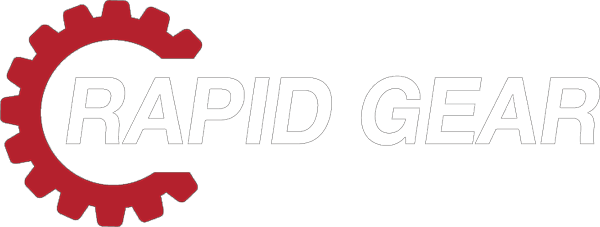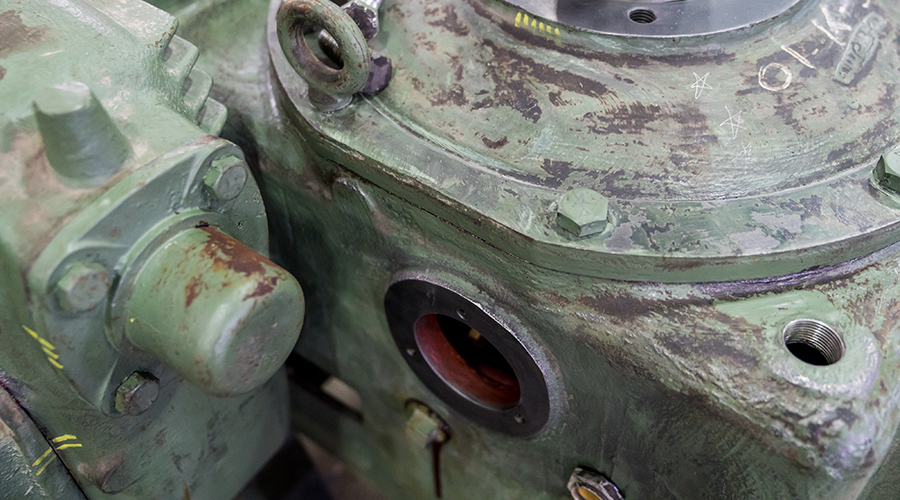Gear Reducers are complex designs that utilize the science of gearing and reduction to run thousands of complex operations in many different industries. OEM gear box companies have designed a variety of boxes for multitudes of different foot prints and reduction capabilities. When failure happen, understanding why and how to fix these units becomes critical to getting the production plant back up and running.
The main factors that cause failure are 1- lubrication or lack of 2- miss alignment and 3- sudden shock or over loading the unit. These failures can result in Bearing failures, and if serious enough, gear damage.
Let’s talk about each failure Mode individually now.
Lubrication is critical for both Bearing performance and gear wear. The proper lubrication is also very critical in the performance of the Gear Reducer for both bearings and for the gear wear. Unknow to most, the lubricant really forms a film that prevents the metal to metal contact as the film is compressed. With most gears being Involute in shape, they tend to roll over each other with that lubrication film as a beerier allowing the force to turn the gears easily with our damage to the metal surface.
Lubrication with contamination will result in pitting and much faster wear for both the bearings as well as the gearing in a box.; thus, it is imperative that maintenance people check the lubrication in all reducers periodically (one for year as an minimum) for contamination. Each box would have a minimum level as well as a method to lubricate both the bearings as well as the gear set. In some cases, it can be forced lubricated especially in very fast speed boxes or where the back lash is minimal, and lubrication must get directed into the contacting teeth.
The second point is alignment. Gears are designed very accurately to mesh to a specification with a specific backlash. The alignment of the gears in the box are critical, especially when a re build is required. One must not assume the box is also aligned. In mining applications where Reducers are in heavy application, we sometimes see first hand that reducer housings can get distorted or bent. Every small amount of miss alignment can cause premature gear wear and failure. The gear teeth will not meet at the correct pressure angle resulting in excessive loads in the weaker parts of the teeth. Spun bearings also can cause wear in the bores causing miss alignment if not corrected by either spray welding and then re machining or using other methods like sleeving if room permits. Various stress and vibrations in the in put / out put shafts can also cause pre-mature wear and transmit stress internal causing problems; thus, external alignment and properly maintained components integral to the system also must be maintained.
When receiving a reducer from a mine for re build, we should understand the full application well including in put forces, out put requirements, cause of failure if suspected, any previous maintenance history, and vibrational analysis and lubrication contamination to name a few. Once the reducer in in the shop, a full disassembly will take place with Photo documentation and labeling of parts. Gear inspection will include an MPI of the teeth and any wear patterns documented. Not all re builds will require Gearing, in most cases bearing and seals will be required only unless the failure is more catastrophic or contamination and or mis alignment has been in place for a longer time. The Mill rights will make a full report on every detail so that parts can me ordered or manufactured to complete the re build. An engineer will then measure & reverse engineer any gearing so that those can be replaced if required. Some of the larger and older reducers are no longer made so OEM supply would be imposable. Even if an OEM can supply parts, the lead time are prohibitive in many cases especial for emergency repairs.
Each Reducer is rebuilt after full cleaning, part replacements, Housing re checked for center distances and alignment (housings would be re machined if not) and then tested for back lash, leakage and running on a test stand. Finally, the box is re labelled and painted to look new.
The last Point to discuss would be sudden shocking or over loading the gear reducer. We see repeatedly that reducers are pushed to the limits and beyond. Conveyers are set to speed up, heavier loads are applied to the outputs and emergency stops and or cold starts can ad shock to the reducers beyond there typical ratings. In older reducers, just the normal wearing of parts can change the stack up internally and cause problems down the road. Once a critical limit is reached, failure will occur quickly.
It can be difficult for the mines to know when and how much extra stress a reducer can take, but once it started to heat up, draws more energy to run, make noises and vibrate, time for a re building becomes critical. The longer a box runs once failures start, the faster it will fail. If let to run for prolonged periods of times, the re build cost will also escalate due to potential gear damages taking place on top of bearings and seals. At this time the re build time line also extends because gear cutting/ heat treatment will take time.
It is wise for any large facility to have spare bearings, seals and or full gear reducers on site to get back up and running quickly after a failure. Then the faulty reducer can be re build and become the new spare with out being rushed resulting in over time fees. In very large reducers, the internal parts (bearings and gears can become very expensive, but not just figural, but in the leads times causing excessive downtime costs.
In summary, smart monitoring, careful inventory of critical parts, preventative maintenance programs that full check the oil temperature, oil contamination, vibrational monitoring, etc. will all help minimise your downtime. Having good partnerships with rebuild shops that are full service and turn key will also ensure quality rebuilding. As more and more facilities out source re building services, understanding what your suppliers can and can’t do are critical.
Rapid Gear is a OEM supplier of custom gearing and precision machines parts. We can cut gears from 2 “to 200 “and also supply OEM gearing to mining applications globally.
As part of our MRO services as a full turn key supplier, we also offer a full re building programs including reverse engineering for any make or brand of gear reducer. Our limits in size can exceed 30 tons. We also offer loose gearing to facilities that would rebuild reducers them selves and can ad in service personal on site if required for technical assistance.
Written by Renato Foti, Director of Business development at Rapid Gear in Kitchener.

